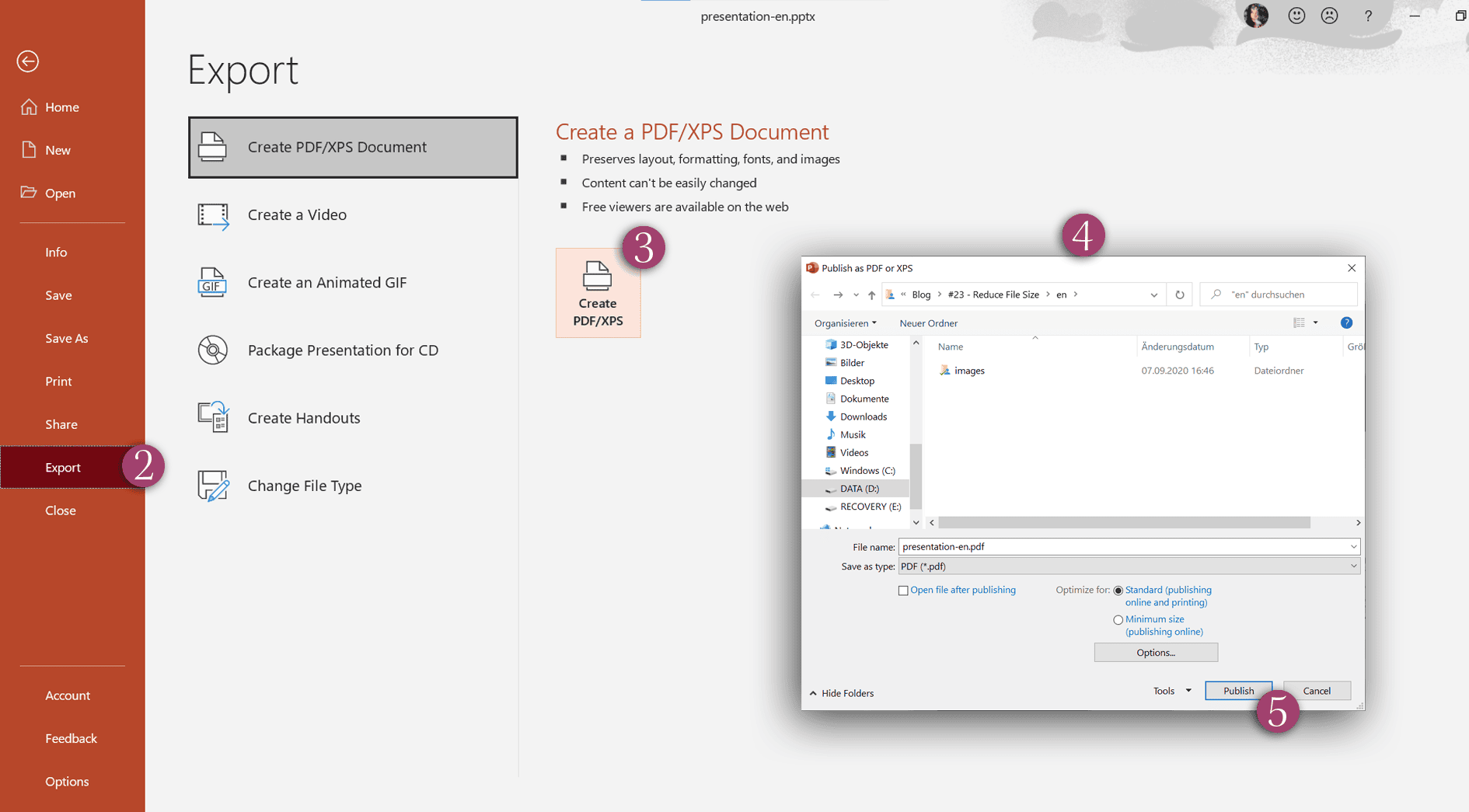Compress Audio Files Powerpoint
To compress video and audio media in a PowerPoint file: Save a copy of the presentation that contains the video and / or audio you want to compress. The media files must be embedded, not linked. Online videos (such as YouTube videos) will not be compressed.
Emailing a PowerPoint presentation isn’t as simple as it seems. You need to consider if your file is compressed enough for easy e-mail attachment.
To compress videos and/or media files in PowerPoint, simply: Navigate to the File tab. Select the Info t ab. Open the Compress Media drop down. Choose a compression file size (Full HD 1080p, HD 720p or Standard 480p) Choosing a compression size, PowerPoint begins compressing all of the videos within your presentation. Why compress PPT files? PPT also goes by the name of PowerPoint Presentation and are used in all walks of life including the home, school and at work. PPT files can range in size depending on the content of the presentation.

There are other important factors to consider. You can’t be there to supervise how your deck is to be viewed, and your deck will be shown on a different computer. There may also be some formatting or compatibility issues you won’t detect.
Issues with audio playback failure and unmanageable audio file size are some of the common problems that viewers and presenters face. Address this common problem with a simple solution. Embed your audio clips and optimize your audio to save yourself the hassle.
- To compress media in PowerPoint: Open the presentation that contains the audio or video files you want to compress. Save a copy of the presentation so you can retain a copy of the file with the original media. In the copy, click the File tab in the Ribbon.
- Compress MP4, MOV, MP3, PDF, PNG, JPG, JPEG, GIF files online for free. Reduce file size of videos, PDF documents, MP3 audio files and images. Free online file compression tool lets you compress large files to make them smaller. No registration, no watermarks, free to use for anyone.
Here’s why embedding can assist your PowerPoint:

What about Embedding?
In previous versions of PowerPoint, you had the choice between linking and embedding your audio. The latter is more appropriate for storing audio clips within your presentation. Linking requires access to files on your hard drive. If the recipient of your presentation has no copy of the linked audio, it will be flagged as missing, and the music won’t play.
That’s why it’s recommended to embed sounds into your PowerPoint file. By default, only .wav files under 100KB each can be embedded.
If you’re planning to increase the size of the embedded sound, a maximum of 50MB is acceptable—but it may noticeably slow your presentation down.
In PowerPoint 2013, there’s no clear limit to how much audio you can embed in a deck. Your main concern is how to send your file once it exceeds your e-mail attachment limitation. For example, Google has a 25MB file limit for email attachments.
It might be inconvenient for your recipient if you redirect them to Google Drive to download your file. Since uploading or downloading large files might take longer, you need to keep your PowerPoint file under a manageable size so that your recipient will get your file without any problem.
How Embedding Works
This tutorial uses the Windows 10 operating system. Let’s embed audio in PowerPoint 2013 by first making sure you have your speakers or headphones plugged in. Without a way to listen to sound, you’ll get an error message that will prevent you from inserting audio:
Once you’ve plugged in your headphones or speakers, the program will now allow you to insert an audio file.
Compress Audio Files Powerpoint Online
SlideGenius Tip:
Pay attention to what View you’re using. You won’t be able to insert audio from the Slide Sorter View, Notes Page View, Reading View, Handout Master View, and Notes Master View. Let’s use Normal View for this tutorial.
1. Go to the Insert.
2. Click on the Audio icon under the Media group at the far right.
3. A dropdown menu will reveal two options. Choose “Audio on my PC…”.
4. A window called Insert Audio will appear. Choose the audio file you want to embed.
PowerPoint 2013 can embed audio files with the following extensions: (AIFF Audio file) .aiff, (AU Audio file) .au, (MIDI file) .mid or .midi, (MP3 Audio file) .mp3, (Windows Audio file) .wav, and (Windows Media Audio file) .wma. Only versions of PowerPoint 2013 and later can support (Advanced Audio Coding – MPEG-4 Audio file) .m4a and .mp4. The Microsoft Office page provides these details and more.
5. Once you’ve made your choice, click Insert in the lower right corner of the window.

6. Your audio file will now appear on your slide with a sound icon.
Optimize your Audio File
This version of PowerPoint has improved the use of audio in presentations. It now has two new features: optimization and compression.
Because embedded audios can now be optimized, files can be smaller using the Advanced Audio Coding technique. This leaves you free from worrying about audio quality.
To optimize audio clips, click on the File menu and go to the Info page, then select Optimize Compatibility in the Optimize Media Compatibility group. If this option can’t be found, the audio has either already been optimized or can’t be optimized for whatever reason.
Your clips can also be compressed to reduce your deck’s file size. Click on the File menu and go to Info. Under the Media Size and Performance group, click on Compress Media. There are three quality options: Presentation Quality, Internet Quality, and Low Quality.
Just be aware that the more you compress a file, the more its quality gets reduced.
Other Methods of Embedding Audio Files
Compress Audio File Powerpoint
Click the Audio icon from the Media group under the Insert tab. Select “Record Audio…” from the list. A small recording menu named Record Sound will appear.
Press the red button to start recording, and the blue square when you’re finished. A sound icon will appear on the slide with recorded audio.

Conclusion
Sharing and uploading presentations online can be less of a chore with our tips on embedding and optimizing your file.
Similar to live speeches, you may also encounter unexpected technical problems that can undermine your credibility. Sidestep the audio playback issues by embedding them straight into your PowerPoint file.
References:
Lipera, Roger. “Working with Sound in PowerPoint 2013.” Interactive Media Center. January 2014. titus.ulib.albany.edu/imc/pdf/WorkingWithSoundinPowerPoint2013.pdf
“Add Audio to Your Presentation.” Office. n.d. support.office.com/en-US/article/Add-audio-to-your-presentation-c3b2a9fd-2547-41d9-9182-3dfaa58f1316
“Compress the Media Files in Your Presentation.” Office. n.d. support.office.com/en-us/article/Compress-the-media-files-in-your-presentation-f0927964-25f3-460c-ac42-c6cc3308604c
“Video and Audio File Formats Supported in PowerPoint.” Office. n.d. support.office.com/en-US/article/Video-and-audio-file-formats-supported-in-PowerPoint-d8b12450-26db-4c7b-a5c1-593d3418fb59
“PowerPoint 2013: Improved Audio and Video Options.” TEL@Tees. February 3, 2015. blogs.tees.ac.uk/teltees/2015/02/03/powerpoint-2013-improved-audio-and-video-options
Recent versions of PowerPoint accept more video file formats than previous versions, and can do a lot more with videos, includingtrimming of video clips. However, it also embeds all inserted video clipsby default, and this can result in huge presentations that contain huge video files! This ultimately occupies oodles of disk space and may also makePowerPoint work a wee bit slower. To tackle this problem, you can explore media compression abilities built right inside PowerPoint. You no longerneed any third-party media compression tool since PowerPoint's native Media Compression options make this task very easy indeed.

Follow these steps to learn more about video compression options in PowerPoint 2016:
- Open a presentation where you have already inserted a video clip thatyou want to compress. Optionally, save your presentation as a new file if you also want to have an original, uncompressed version of thepresentation.
- Now, access the File menu, and choose theInfo Pane, as shown in Figure 1. Thereafter,click the Compress Media button, highlighted in red within Figure 1.
Figure 1: Compress Media button within the Info paneTip: Do not see any Compress Media button? This option shows up only if you have video or audio clips insertedwithin PowerPoint. There are exceptions too. You will not see the Compress Media button if you used anonline video. Also, if you choose to link a video clip rather thanembedding it, this button will be visible, but grayed out. To learn how to link a video rather than embed it within a presentation, look atstep 3 in our Insert Video (Movie) Clips in PowerPoint2016 tutorial. - This brings up the Compress Media drop-down menu, as shown in Figure 2.
Figure 2: Compress Media drop-down menu
The top three options within the Compress Media drop-down menu are explained below:
Presentation Quality: Helps save space and also at the same time maintains the overall audio and video quality.
Internet Quality: Video quality post compression is comparable to video typically streamed over the internet.
Low Quality: Produces video of very low quality hence can be used when file size is more important than quality.
Click to choose any one of the compression quality levels. - This opens the Compress Media window which shows the compression process. Once the compression is done, you can see the diskspace you saved at the bottom of the Compress Media window, as shown in Figure 3.
Figure 3: Compress Media window - Click the Close button to get back toBackstage view.
- Preview your video after compression, if you are unhappy with the compression result you can undo the compression. To do so, click theCompress Media button again, and select the Undo option from the resultant drop-down menu, as shown inFigure 4.
Figure 4: Undo option to revert compressionNote: The Undo compression option will be available only till the presentation is open. As soon as you save andclose the presentation, the compression will be permanently applied to your video clip. Close your presentation only if you are happy with thecompression.Note: Compression of any type will finalize any Trim Videooptions you chose. After compression, all parts of the video that were trimmed away will no longer be available. Also, theReset options will only reset the appearance of the video. - Make sure you save your presentation.
See Also:
Video Compression Options in PowerPoint 2013 for Windows
Video Compression Options in PowerPoint 2010 for Windows